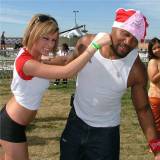Awful review: Dead or Alive 3 (Xbox)
By FalcomAdol 1 Comments
DOA3 is the Xbox successor to the SEGA Saturn game Dead or Alive and the Dreamcast game Dead or Alive 2. It follows in their footsteps, with a compelling high level fighting system, realistic physics, and characters with high levels of physical beauty.
As in other fighting game series, this new edition adds new combat areas, a couple of new fighters, and a brand spanking new end boss designed specifically to piss you off.
The best of the new fighters are, solid additions that increase the number of available fighting styles, instead of just adding a new name to the gameday roster (*cough* Leon *cough*). Hitomi, the superior new female character, uses a power oriented karete style with lots of straight legged kicks and strong punches that do lots of damage, but have less flow than the ninja characters. This power style suits the character well to newcomers to the series or to fighting games. The new male character, Brad Wong, uses a drunken style (although unlike forbears in the Virtua Fighter and other games, he doesn't drink while on the job). His pacing is entirely different from that of other characters in the series to date. Once you come to grips with the timing necessary to string together his attacks, you can do substantial damage in a short period of time. Because of the need for precise timing and a solid grasp of the available moves, and how best to string them together, I consider him an advanced character, somewhat like Mitsurugi of Soul Calibur.
The other two new characters, Christie (an English assassin who uses a tiger / mantis style), and Hayate (a ninja in a similar vein as Hayabusa), provide new story hooks, but have less interesting fighting styles.
The combat zones have been entirely revamped. The outdoor zones are full of scampering or resting animals, and as in DOA2, include many levels suitable for sending your opponent flying 10s of meters downward. The few remaining enclosed zones are filled with onlookers, and there are fewer "danger zone" oriented areas, with a larger emphasis on wall juggling combos somewhat similar to those in the Fighting Vipers series (although with gravity much closer to that in real life), rather than the explosive environmental damage of the original DOA (don't fool yourself though, that's still here too).
Unfortunately, unlike it's predecessors, there are very few unlockable extras in this game. A limited number of additional costumes can be downloaded from one of the Exhibition discs (or on the Dead or Alive Ultimate discs), and by meeting certain circumstances, you can unlock Bayman as a playable character, but the insane desire to run through story mode just one more time to unlock Kasumi's 17th costume is no longer present.
Perhaps this is a good thing though, because the final boss in story mode is even more annoying and frustrating than Tengu from DOA2. Once again, most of the challenge comes cheaply from a skewed camera perspective and an enemy that easily tosses you back with special moves. Once again, defeating the enemy involves finally getting close enough to land a few punches, and hitting it with your most powerful moves. In my opinion, this type of boss battle is counter to the entire spirit of the DOA series, which has relied on depth and balance in characters instead of a cheap fireballing turtle scheme. Battles are like a ballet, with characters exchanging blows, countering each others moves, and pressing the advantage when the opponent is vulnerable. These are the gameplay elements that drew players into the game after the voyeuristic novelty of independent breast movement (perhaps unsurprisingly reined in in more recent installments) wore off. Happily, in player versus player action, the game still holds to that high standard of balance, mobility, and true to life (or at least film) combat.
As one of the earliest million sellers on Xbox, the game is widely available now in platinum hits packaging. Since the release of Dead or Alive Ultimate (a remake of DOA2 on an improved DOA3 engine, paired with a port of the Saturn version of DOA), Dead or Alive 3 has also been appearing with regularity in the used game bins for ten dollars or less. At those prices, almost anyone can rationalize grabbing this game that hasn't played it yet, even with Xbox360 on the horizon.

1 Comments